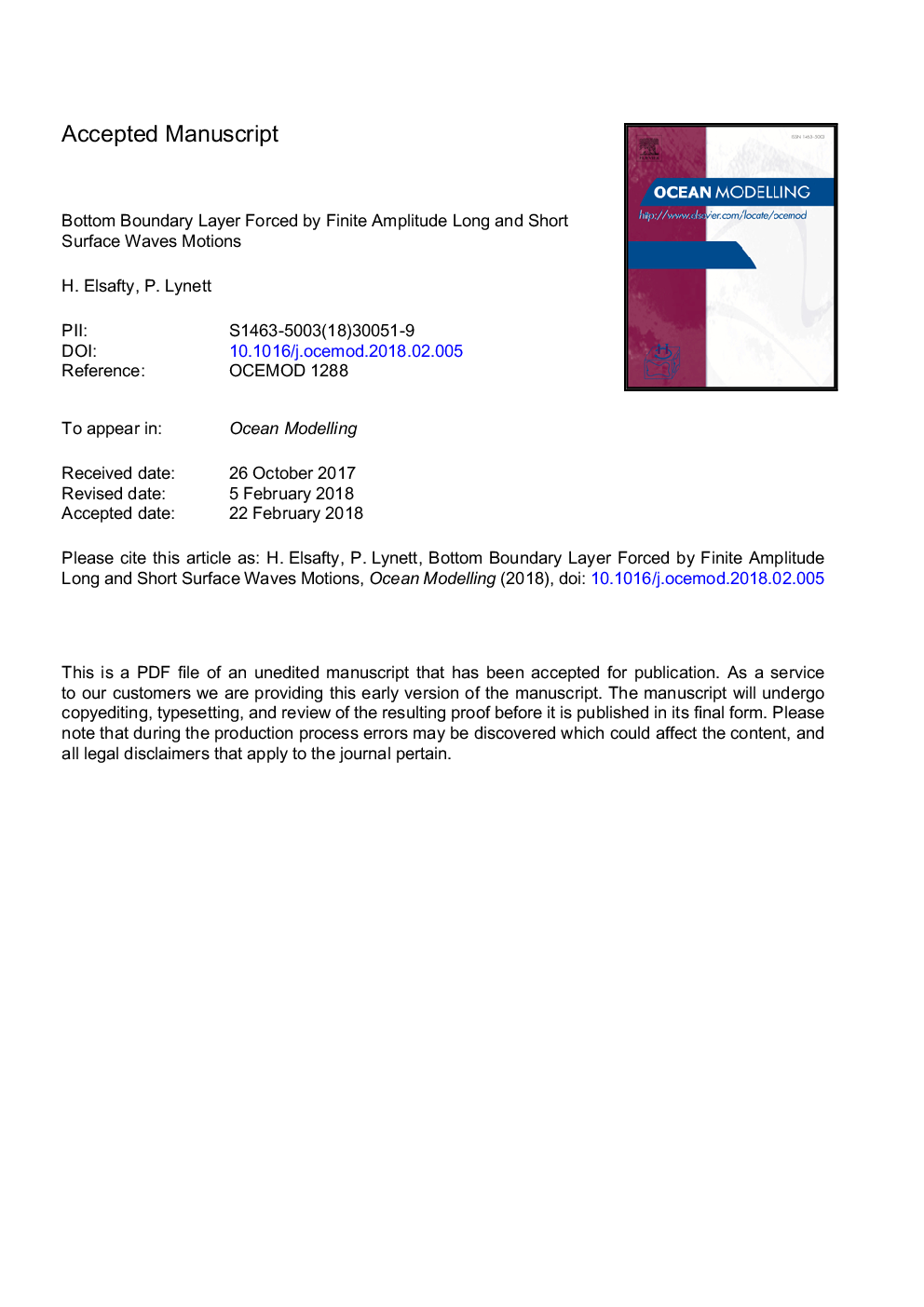| کد مقاله | کد نشریه | سال انتشار | مقاله انگلیسی | نسخه تمام متن |
|---|---|---|---|---|
| 8886520 | 1627725 | 2018 | 29 صفحه PDF | دانلود رایگان |
عنوان انگلیسی مقاله ISI
Bottom boundary layer forced by finite amplitude long and short surface waves motions
ترجمه فارسی عنوان
لایه مرزی پایین به دلیل حرکات امواج سطح و طول موج دامنه محدود می
دانلود مقاله + سفارش ترجمه
دانلود مقاله ISI انگلیسی
رایگان برای ایرانیان
کلمات کلیدی
اختلال در مقیاس چندگانه، دو حرکت نوسانی، حرکتهای انفرادی، Ï ؟؟ - مختصات، لایه مرزی پایین
ترجمه چکیده
رویکرد آشفتگی در مقیاس چندگانه برای حل معادلات ناویه-استوکس در حالی که شامل اثرات لایه های مرزی پایین تحت یک موج تک و تحت دو امواج درهم تعامل است، اجرا شده است. در این روش، سرعت های مایع و میدان فشار به دو بخش تقسیم می شوند: یک مولفه بالقوه و یک مولفه چرخشی. در این مطالعه، دو جزء در سراسر ستون آب وجود دارد و هر کدام با مقیاس طول و زمان مناسب مقیاس می شوند. اتصال دوطرفه بین دو جزء اجرا می شود. مولفه بالقوه فرض شده است که به صورت تحلیلی یا عددی شناخته شده قبل از آن است و مولفه چرخشی توسط مولفه احتمالی اجباری است. از طریق نظرسنجی از اندازه گیری، متوجه می شویم که اتصال دوطرفه بین دو اجزای اصلی از طریق شتاب عمودی کنتراست اتفاق می افتد. نشان داده شده است که این اتصال نقش مهمی در رفتار لایه مرزی دارد. اثر آن بر نتایج برای شرایط مختلف موجی مورد بحث قرار می گیرد: اجباری کاملا هارمونیک و اجباری ناخالص هارمونیک. پس از آن روش برای به دست آوردن معادلات حاکم برای لایه مرزی پایین ایجاد شده در زیر دو موج حرکت تعاملی اعمال می شود. هر دو حرکت، موج کوتاه و طولانی، به دو قسمت تقسیم می شوند، پتانسیل و چرخشی، همانطور که در موج تک انجام می شود. موارد تست ارائه شده است در حالی که دو موج مختلف موج شبیه سازی شده اند: (1) دو حرکت حرکت نوسانی دوره ای و (2) موج های کوتاه در تعامل با یک موج انفرادی. تجزیه و تحلیل دو حرکت دوره ای نشان می دهد که اثرات غیر خطی در راه حل چرخشی ممکن است قابل توجه باشد، حتی اگر اثرات غیرخطی در جابجایی بالقوه ناچیز باشد. تفاوت های محلی در سرعت چرخشی به علت اصطکاک کوپلینگ عمودی غیر خطی به ترتیب 30٪ از حداکثر حداکثر سرعت لایه مرزی برای موارد شبیه سازی شده در این مقاله می باشد. انتظار می رود این تفاوت با افزایش غیرخطی موج افزایش یابد.
موضوعات مرتبط
مهندسی و علوم پایه
علوم زمین و سیارات
علم هواشناسی
چکیده انگلیسی
A multiple-scale perturbation approach is implemented to solve the Navier-Stokes equations while including bottom boundary layer effects under a single wave and under two interacting waves. In this approach, fluid velocities and the pressure field are decomposed into two components: a potential component and a rotational component. In this study, the two components are exist throughout the entire water column and each is scaled with appropriate length and time scales. A one-way coupling between the two components is implemented. The potential component is assumed to be known analytically or numerically a prior, and the rotational component is forced by the potential component. Through order of magnitude analysis, it is found that the leading-order coupling between the two components occurs through the vertical convective acceleration. It is shown that this coupling plays an important role in the bottom boundary layer behavior. Its effect on the results is discussed for different wave-forcing conditions: purely harmonic forcing and impurely harmonic forcing. The approach is then applied to derive the governing equations for the bottom boundary layer developed under two interacting wave motions. Both motions-the shorter and the longer wave-are decomposed into two components, potential and rotational, as it is done in the single wave. Test cases are presented wherein two different wave forcings are simulated: (1) two periodic oscillatory motions and (2) short waves interacting with a solitary wave. The analysis of the two periodic motions indicates that nonlinear effects in the rotational solution may be significant even though nonlinear effects are negligible in the potential forcing. The local differences in the rotational velocity due to the nonlinear vertical convection coupling term are found to be on the order of 30% of the maximum boundary layer velocity for the cases simulated in this paper. This difference is expected to increase with the increase in wave nonlinearity.
ناشر
Database: Elsevier - ScienceDirect (ساینس دایرکت)
Journal: Ocean Modelling - Volume 124, April 2018, Pages 48-60
Journal: Ocean Modelling - Volume 124, April 2018, Pages 48-60
نویسندگان
H. Elsafty, P. Lynett,
